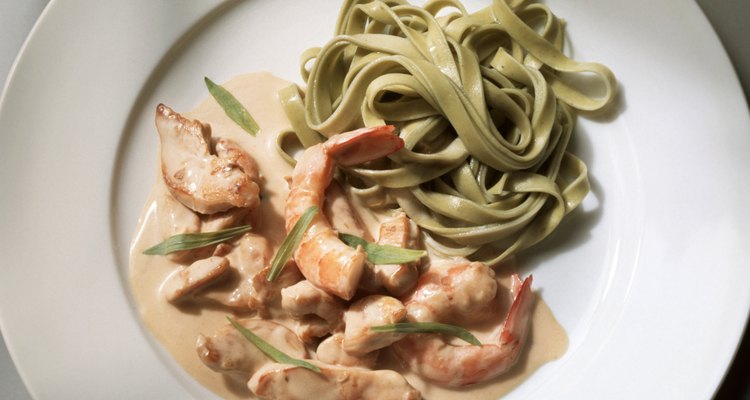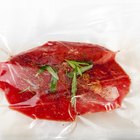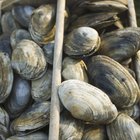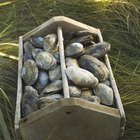
Eising/Photodisc/Getty Images
Shrimp are about as versatile as any seafood could possibly be. They can be eaten hot or cold, grilled or poached, as a colorful garnish or as the main meal themselves. You can buy them fresh, frozen or "previously frozen" in most stores, which raises a question about food safety. Refreezing thawed seafood certainly poses a potential problem, but you can do it safely if you understand and follow the proper steps.
Keeping Out of Danger
The food safety pamphlets you see online or at your supermarket place a lot of emphasis on the food safety "danger zone." That falls between 40 and 140 degrees Fahrenheit, the 100-degree temperature range that favors bacterial activity. At lower temperatures, bacteria struggle to reproduce, while at higher temperatures they're occupied with simple survival. To ensure your shrimp are safe to refreeze, you need to minimize the time they spend in that range of temperatures. Ideally you'd keep them on ice or in a cooler while driving home, then refrigerate them immediately. If you buy the shrimp frozen and thaw them yourself, the thawing method you choose becomes critical.
Thawing Is Key
Shrimp are relatively small, and can be thawed quickly. Some cooks leave them on the counter, while others thaw them in cold water or even in the microwave. If you want the option of refreezing, you can't do any of those things. Countertop thawing is never safe, and if you use the water or microwave methods, you'll need to cook the shrimp on the same day. The only safe way to thaw shrimp is in your refrigerator, which takes 12 to 24 hours of advance planning. Your fridge maintains a safe temperature below 40 F -- that's what it's for -- so your shrimp never reach an unsafe temperature as they thaw.
Refreezing and Safety
The refrigerator life of fresh or thawed shrimp is short, only one to two days, so the less time they're thawed, the better. As soon as you decide to put off cooking them, or as soon as you bring thawed shrimp home from the store, pop them into the freezer. Make a note on the package, so you'll know that they've already been thawed at least once. The next time they come out of your freezer, they'll need to be either used or discarded, in part to avoid food safety issues and in part because of quality concerns.
That Quality Thing
Like any other muscle tissue, a shrimp's body contains a high percentage of water. When you freeze them, the water filling a shrimp's muscle cells expands exactly like an ice cube in its tray. When that happens, some of the cell walls rupture under the strain of the expanding ice crystals. After they're thawed, some of the moisture will leak from those shrimp, leaving them drier and less flavorful than fresh or once-thawed shrimp. In extreme cases, the shrimp's flesh can become mushy, losing the distinctive firmness that's part of their appeal. Whenever possible, use twice-thawed shrimp in soups, dips, sauces and casseroles to conceal these shortcomings.
Related Articles

How Long Can Shrimp Be Refrigerated?

Can You Cook Shrimp Without Thawing ...
How to Thaw, Cook & Refreeze Vegetables
Can You Thaw & Refreeze Clams?

How to Cook Shrimp With Butter

Rules for Thawing and Refreezing Meat
Do I Steam or Boil Shrimp?

What Is the Fastest Way I Can Defrost ...

How to Defrost a Steak and Keep It ...

How Long Do Clams Last Unrefrigerated?

Which Vegetables Can Be Frozen?
Can You Freeze Shish Kabobs?

Jumbo Shrimp Nutritional Facts

How to Steam Lobster & Shrimp

How to Cook Clams in the Shell

Can You Freeze Canned Goods?

How to Cook Shucked Frozen Clams

How to Prepare Live Shrimp

How to Thaw Frozen Cooked Shrimp Quickly
Can We Refreeze Frozen Vegetables?
References
- On Food and Cooking: The Science and Lore of the Kitchen; Harold McGee
- U.S. Department of Agriculture Food Safety and Inspection Service: Freezing and Food Safety
- U.S. Department of Agriculture Food Safety and Inspection Service: The Big Thaw -- Safe Defrosting Methods for Consumers
Writer Bio
Fred Decker is a trained chef and prolific freelance writer. In previous careers, he sold insurance and mutual funds, and was a longtime retailer. He was educated at Memorial University of Newfoundland and the Northern Alberta Institute of Technology. His articles have appeared on numerous home and garden sites including GoneOutdoors, TheNest and eHow.
Photo Credits
Eising/Photodisc/Getty Images